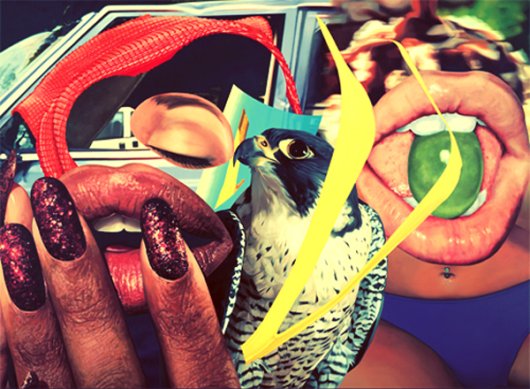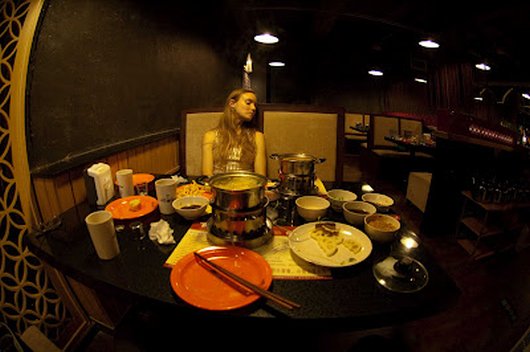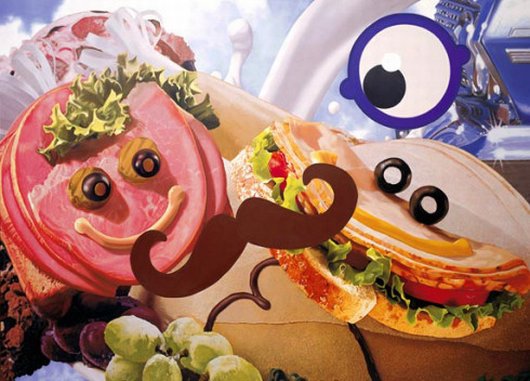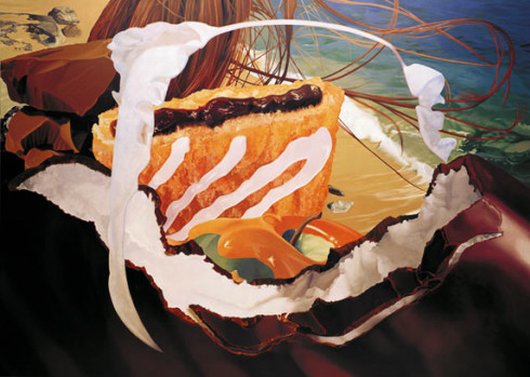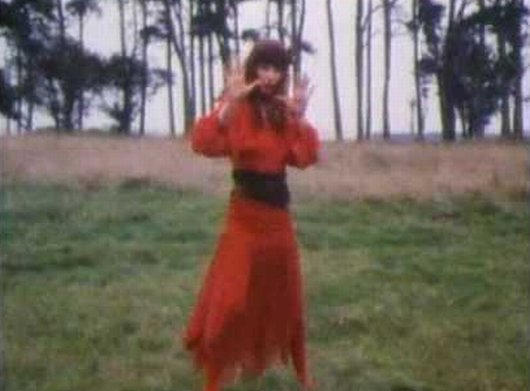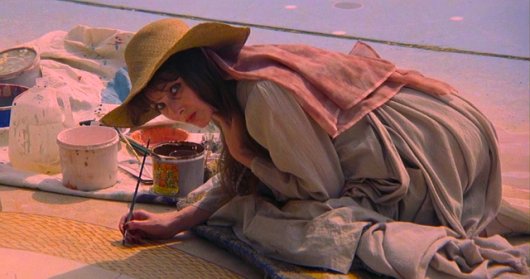 SF
SF In Which The Flowers Trump the Paintings
 Monday, March 26, 2012 at 10:33AM
Monday, March 26, 2012 at 10:33AM 
Flora/Fauna
by MOLLY O'BRIEN
I was in California for the first time ever last week. All the predictable Bay Area-type things happened: redwood trees in Muir Woods dwarfed me, a homeless man sitting next to me on the bus stroked the furry trim on my winter coat, and I ate a salad whose varied lettuces hadn’t spent more than ten minutes in the back of a produce truck.
Going on vacation in a place where powdery sand beaches are not the point is a bit stressful because one feels the constant need to do "cultural" or at least "metropolitan" things. I felt this in San Francisco in the same way I did when I studied abroad. Culture seems less tenuous when in a strange city; it’s more tangible, almost like a substance one can mine, refine and imbibe.

And museums are the true cultural jewel box: you visit, you look, you absorb, you maybe take down some notes in a black leather notebook, and you leave with buzzy-tired legs and a feeling that you’ve done it – you’ve taken the culture like a vitamin, and now you’re free to spend the rest of the day watching month-old Conan reruns in the hotel room.
The de Young Museum in Golden Gate Park follows a fairly typical art museum template. The building is quite large, with a brushed metal exterior and an extremely subtle Andy Goldsworthy work outside. (It’s one continuous crack in the paving stones.) Across the park is the California Academy of Sciences building, whose grass-and-glass-covered domes and flashy signs for child-friendly exhibitions make the de Young’s exterior appear sober and reserved.

Inside the minimalist metal building is an observation tower, a subterranean coat check and about seven different bookstores. (I have never seen so many Exit Through the Gift Shop DVDs in one single location.) When I visited, the offerings were standard and pleasant: a traveling photography exhibition, an early 20th-century sculpture show, a Rothko here, a Rauschenberg there, African masks and Turkish textiles and that famous Wayne Thiebaud painting of three gumball machines.
I visited the de Young on the second day of their big annual event, the Bouquets to Art exhibition, in which florists from all over San Francisco create flower displays that ape certain artworks in the museum. I did not anticipate the sheer number of people present when I arrived at 11:30 am. The demographic was by and large ladies over the age of 65.
These particular ladies were splendid. All the usual septuagenarian lipstick shades: burgundy, cranberry, coral, mauve. Heavily embroidered coats, some fortified by plastic rain ponchos removed and recycled at the door. Ladies herded each other into large groups or promenaded around in duos, clutching each other at the elbows. It was charming. In the cavernous lobby, their chatter reverberated into a sort of high school cafeteria din.

I bought a ticket and maneuvered into the modern wing. Old ladies everywhere. The manner in which people were circulating through the exhibition was clear as soon as I came in: the lucky artworks that had been granted matching floral arrangements attracted most of the traffic, and paintings ignored by the artsy florists were spurned in kind by the museum-goers. The traffic swirled in tight circles around the flowers, like bees. From above it would have looked like Doppler radar footage of hurricanes.
The incredible thing was that none of the old ladies seemed to be looking at the original paintings and sculptures that the floral arrangers had used as their sources. I tried to look at the lookers, follow their gazes, see if they were studying the flowers and paintings simultaneously or one at a time, and found that they were gawking only at the blooms. I had thought Bouquets to Art would be a clever merging of art forms, a potent aesthetic convergence, a Yalta Conference of hallowed fine art and irreverent craft art, but mostly it was a chance for people to marvel at decorative botanical feats.

Something about the multitude of acid-bright blooms or the sheer size of the crowd induced a low-level mania in everyone. People were doing things that shouldn’t have been done in a museum: they squeezed between pedestals that were dangerously close to one another (one woman nearly upset an unstable Stephen de Staebler rock sculpture), they sniffed the flowers with passionate inhalations (the image of Happy the Snow White dwarf, suctioning a bouquet of goldenrods up his nostrils, came to mind), they got close enough to touch everything, they bumped past each other as if drugged and disoriented. This wasn’t Stendhal syndrome, the dizziness and confusion that one can feel in the presence of masterpieces; it was no different than the madness that occasionally possesses people in crowded subway cars. Spring fever, cabin fever.
Once I became aware of the old ladies’ abandoning of the unflowered paintings, I personified those paintings and pitied them. Shy, unaugmented by the apparently magical touch of the florists, they were literal wallflowers. I paid more attention to them, wiggled around the groups of fawning flower-lovers and looked at the unadorned art with adoring eyes.

There were Arthur Tress’s photos of San Francisco in 1964, all snapshots of Barry Goldwater supporters and beehived beach bums and girls holding signs that read “Ringo For President.” The 70-year-olds I saw in the museum would have been young and maybe even optimistic in ‘64 – if they were lifetime San Franciscans, they might have even been in those Tress photos of idealistic youths at the Republican National Convention. There was Irving Petlin’s "The Burning of Los Angeles", so large it took up an entire wall.
“That’s a big ‘un,” said one lady to another, pointing at the painting’s blaze of color as both women moved onto the next floral arrangement. Evidently no florist had volunteered to recreate the orange swirls with tiger lilies, the twisted, fleeing figures with tasteful branches of bamboo. In the next gallery, a prim and proper 19th-century portrait of a puffy young lady merited a flower arrangement equally reserved, stale daisies in neat rows.

The crush of people started to get ridiculous. A German woman turned around in the halted crowd and asked me if her backpack was unzipped. I said no, and I watched her turn back around and fiddle with the backpack’s straps, and then I made what some might see as a fatal mistake: I stopped looking at art and started looking at people. There were a number of striking, tall young women mulling about. They stood in pleasing contrast to the hordes of old women, all of them stooped and mincing. One blonde dame approached a fussy little portrait of a society woman (it had been donated by a Rockefeller), and the blonde’s coat, red and gold and black brocade, nearly matched the coat in the painting. The blonde looked at the painting, and she smiled with the easy recognition of someone looking into a mirror.

It had all gone to hell. I met one of my travel companions in the penumbra of the deserted African wing. We checked out the historical chair collection and picked out our favorites. The museum trip had dissolved into observations about old furniture: “That’s a nice red cushion.” “The Shakers had a very interesting skill set.”
We couldn’t figure out what had happened. Someone proposed that the old ladies were all SF natives who had already seen everything the de Young had to offer and thus didn’t need to go out of their way to appreciate the non-floral art. It was unanimously decided that we were the de Youngest people in the museum. The visit can be summed up by the five minutes I spent looking at Josiah McElhery’s "Model For Total Reflective Abstraction", a collection of globular objects sitting on a platform. The sculpture’s mirrored surfaces encouraged viewers to take in everything in the room: the art on the walls, the other people, the flowers, the flowers, the flowers. You look at art and all you see is something else.
Molly O'Brien is the senior contributor to This Recording. She is a writer living in Burlington. She tumbls here. She last wrote in these pages about Chelsea Handler. You can find an archive of her writing on This Recording here.

"Candy" - Lower Dens (mp3)
"Brains" - Lower Dens (mp3)
"Nova Anthem" - Lower Dens (mp3)

 molly o'brien,
molly o'brien,  museum,
museum,  sf
sf 





























